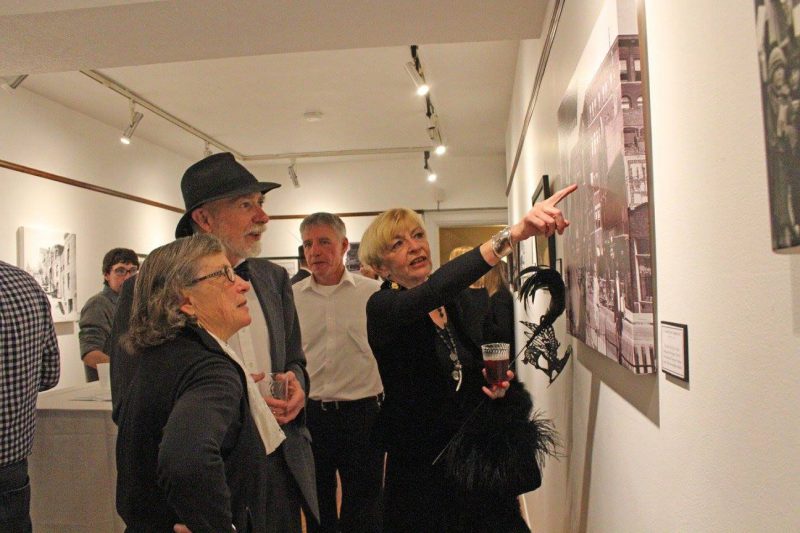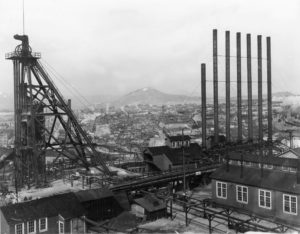
Attendees of the 2016 Night in Black and White fundraiser looking at prints for auction.
The Butte-Silver Bow Public Archives holds its second annual Night in Black and White fundraiser, 6:30 p.m. Oct. 20 at the Clark Chateau, to benefit the conservation of the C. Owen Smithers Photo Collection.

A Night in Black and White features live auctions with never-before-seen images by the photographer, a silent auction, and food, drinks and music. Last year’s gala drew more than 150 people.
This year, the funds will provide the match for the Archives’ National Historic Publication and Records Commission (NHPRC) grant. In 2016, the Butte Public Archives was awarded a $67,480 NHPRC grant to catalog, preserve, and provide unprecedented access to the C. Owen Smithers Photograph Collection.
- Owen Smithers, Sr., or “Smigs” as he became known, was one of Montana’s most prestigious professional photographers. For more than 50 years, he used his camera to document Montana’s history as it happened.
In 2013, the Friends of the Butte-Silver Bow Archives acquired the collection for $120,000 from the Smithers family estate. The collection records 100 years of Butte work, life, and leisure.
NHPRC spokesman Keith Donohue told the Montana Standard, “The Smithers Collection promises to enrich research and study of one of the world’s largest copper mining operations, diverse ethnic groups and immigration, businesses, labor unions and community development, as well as street scenes and daily life.”
Tickets are $50 per person or $80 for couples and may be purchased at the Butte-Silver Bow Public Archives or online. Call 406-782-3280 for details.
Journalist Smithers put his craft to work
Smithers’ parents came to Montana in covered wagons in the 1880s and settled in the area now known as Kalispell. C. Owen was born in 1893 and grew up in Kalispell where he began learning the art of photography and use of the dark room while working in his father’s drug store. In 1914, he became one of the first press photography students at the University of Montana’s new School of Journalism.
Smithers’ military service began when he served with the Montana Volunteers in the Mexican Border Incident of 1916. He went on to serve during World War I as a mess sergeant under General Pershing in France. He returned to active duty during World War II, when he served as the Army Signal Corps Photography Chief based out of New York City and was in charge of all Army Photography Sections in New York, New Jersey, and Delaware.
Smithers first came to Butte in 1921 after his service in the First World War. He first worked as chief photographer for the Anaconda Standard from 1921 to 1923, putting his craft to work on the streets and in the mine yards of Butte, and capturing the ever-changing landscape of the dynamic city.
From 1923 to 1924, he partnered with both Frank Ward and Tom Manning before opening his own photography studio in 1926. From the 1930s until his retirement from the photography business in 1972, Smithers photographed every president of the United States from Herbert Hoover to Richard Nixon, many when they visited Butte, as well as many presidential candidates who did not make it to the White House.
Smithers amassed an impressive collection
In addition to working as a photojournalist, Smithers collected images of Butte and Montana, amassing an impressive collection spanning a period from the 1860s to the 1970s. These images document the development of early mining towns in the West, including the rise of Butte, Montana from a mining camp to a cosmopolitan city.
They also capture the economic hardships felt during the Great Depression. Smithers documented nearly every mining activity, fire, crime, major visitor, and everyday life in Butte from 1921 to 1972. He was active in the American Legion, the Bagdad Shrine Temple, the Scottish Rite of Freemasonry, the Butte Press Club, and the Kiwanis Club – all of which gave him a personal role in the community. His son, C. Owen Smithers, Jr., joined him in the photography business and continued his legacy in Butte.
The elder Smithers dreamed of publishing a photographic history of Montana. To this end, he acquired hundreds of photographs from around Montana taken by his forerunners, including Frank Ward, N.A. Forsyth, and others. These are the images that extend the range of the collection back to the 1860s and include hundreds of photographs of Montana’s early towns, events, and people.
For more, visit https://buttearchives.wordpress.com/2016/06/14/the-life-of-c-owen-smithers/